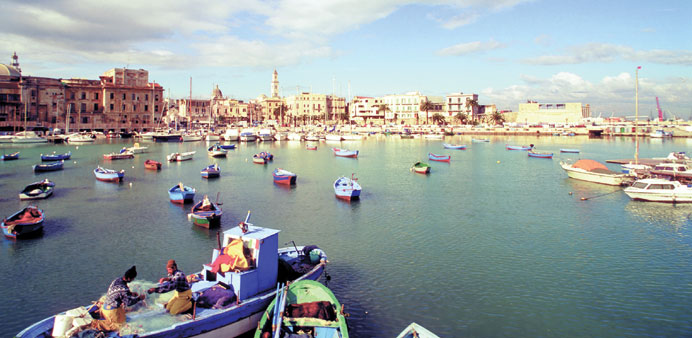By Hanns-Jochen Kaffsack
This man knew how to build for the ages, to put things out in the countryside that gleam in the Mediterranean sunshine and speaks permanence in fast-changing times. The man was the Holy Roman Emperor Frederick II of the Hohenstaufen dynasty of Germany who sprinkled the landscape of Apulia — the Italian mainland’s southern tip — with architectural gems some 800 years ago.
It’s a story of how Frederick (1194-1250) left the searing heat of Sicily, and pursuing his passion for hunting, settled in the densely-forested region around Foggia. North-west of Foggia there’s the town of Lucera with a kastell, or fortress which Frederick initially built. He had arrived with his army of Saracens and there they settled down, a Muslim community in a Christian ambience.
The mighty cathedrals and the castle on the incredibly blue Adriatic Sea: such edifices on the shores between Barletta and Bisceglie, built of a bright white limestone that appears to outshine everything else, form the impressive picture of the city of Trani, located on the road toward southern Apulia.
Here one learns that it was in Trani that the educated and strong-willed Frederick II had sought to win over the Jews — in a period when “multi-cultural” was an unknown concept, though not for this scholarly and multi-lingual Romano-German Emperor “Federico,” King of Sicily and Jerusalem, who himself never was drawn to Germany.
On the back side of Italy’s 1-cent coin is eternalised that which is a highlight of every visit to Apulia — the splendid and mysterious mountain Castel del Monte. It’s an octagonal masterpiece that only Frederick could have thought up. Mighty and white on its mountaintop perch, the monumental castle offers an unforgettable view across the broad landscape.
Monument too is a word that Frederick, who left his mark all over southern Italy, probably would not have enjoyed. Some 800 years later, those buildings of his that have been preserved illustrate a culture that did not fall prey to decadence before going under.
Travelling along the national highway, the visitor is approaching Bari. But just before that, the road leads to the vineyards of the rural town of Ruvo di Puglia with its Roman-style cathedral. It’s a work of clear architecture set beneath a clear sky, elegant in its simplicity.
Still under the spell of such perfection in limestone, the traveller reaches Bitonto, a place that was always at the interface of different cultures. The magnificent cathedral there holds a real surprise: Beneath it there is a complex branch network of corridors belonging to churches that are even older. The corridors have been excavated and perfectly restored and underscore the tradition of building new churches atop the foundations of older ones.
But getting back to the Hohenstaufen emperor, to the man with the eagle with a rabbit in his claws as a symbol of his reign, the best-preserved of his castles is in Gioia del Colle, deep in the heart of the countryside. It is a particularly mighty fort with two defiant towers and feudal chambers.
It was here that Frederick liked to lead a sumptuous lifestyle with one of his companions. Bianca Lancia became the mother of his son Manfred, who would be the last Hohenstaufen to rule over southern Italy.
But there’s also a gruesome side of the story. Frederick, the jealous type, first had Bianca Lancia incarcerated during her pregnancy. She, to prove her fidelity, is said to have “served up” to him the new-born baby on a tray. At least all this happened according to the legend.
After such heavy fare, one needs maybe a bit of fresh Apulian air and a light Italian snack in a town called Noci. In the old town centre, the restaurant “Antica Locanda” in the Via Spirito Santo street offers mouth-watering specialties from the region, completely in line with the culinary philosophy behind the slow-food movement. Slowing down is a way of clearing one’s head, maybe a respite from delving so deeply into the story of Frederick.
And all of a sudden — che bello! — How nice that there is yet a further colourful and stimulating change of pace off the beaten path. After the town of Noci comes Alberobello (pretty tree). It’s like a paradise spot for smurfs and is a Unesco-listed World Cultural Heritage Site. The village consists of houses made of layer upon layer of “trulli” or dry wall topped by cone-shaped rooftops.
Even cruise ship tourists from as far away as Bari and Brindisi stream into Alberobello to admire the dry stone walls and to buy kitsch shaped like the cone-shaped houses. But they may also be buying a fine Apulian olive oil freshly made from an old press.
In the nearby town of Martina Franca, the pretty ensemble of baroque-style palaces, the kind you’ll find here and there in southern Italy, is definitely worth seeing. The equally rustic and characterful trulli houses are actually the prettiest here. Soon you find yourself wandering in the labyrinth of streets in the old centre with its cathedral. So there it is, finally — the sole sacral building ordered and financed by Frederick II.
Yet somehow it does not really stand out in this very southern Italian town, one which is possibly better known for its bread.
Nor is it in Martina Franca that Frederick II is buried.
He died on December 13, 1250 in Castel Fiorentino near Lucera. His mortal remains were laid to rest in the family grave in Palermo on Sicily. But that’s another story. — DPA

The port of Bari, the town which lies at the heart of Apulia.


